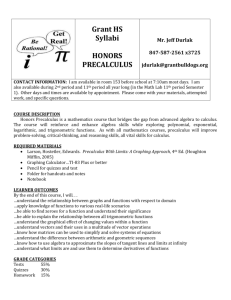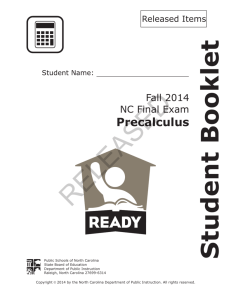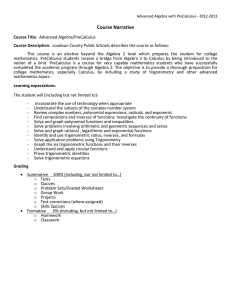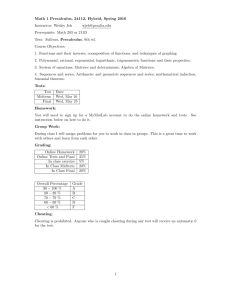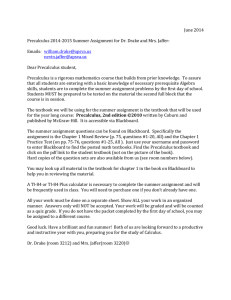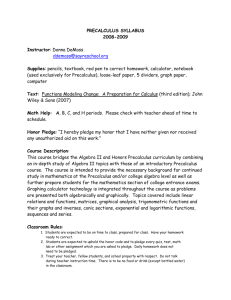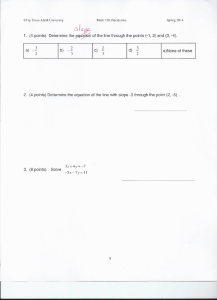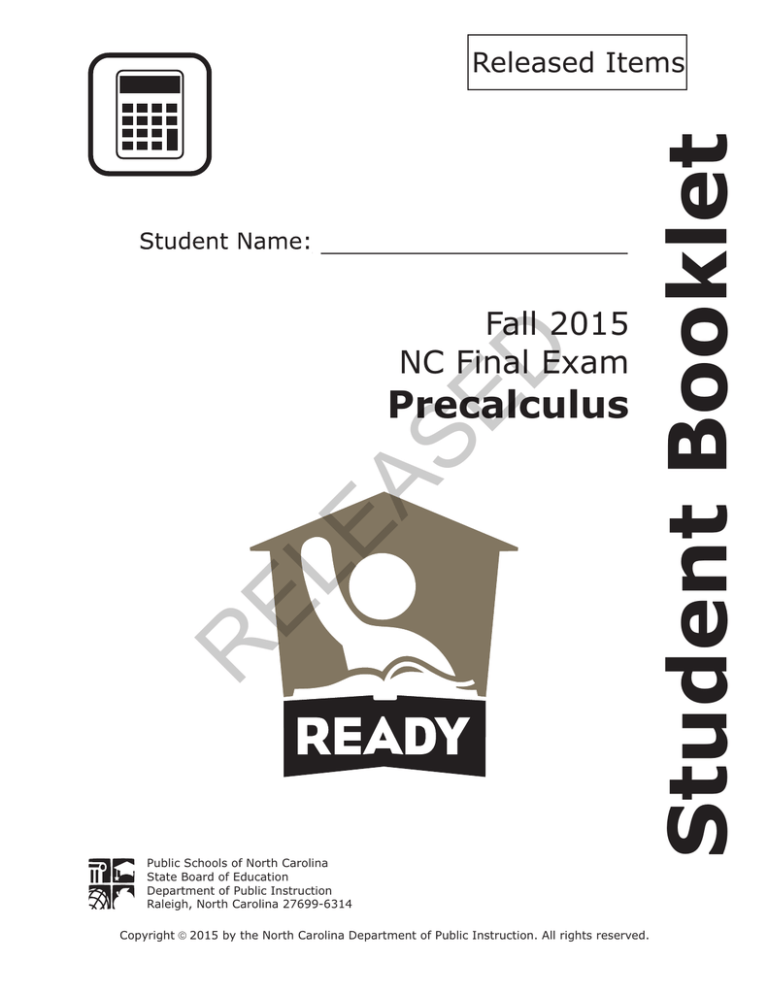
D
Fall 2015
NC Final Exam
R
EL
EA
SE
Precalculus
Public Schools of North Carolina
State Board of Education
Department of Public Instruction
Raleigh, North Carolina 27699-6314
Copyright ã 2015 by the North Carolina Department of Public Instruction. All rights reserved.
Student Booklet
Released Items
PRECALCULUS — RELEASED ITEMS
What transformations have occurred to create the function f(x) = 3x3 – 4 from the
function g(x) = x3?
A
The graph of the function has been stretched horizontally and shifted up
four units.
B
The graph of the function has been stretched vertically and shifted up
four units.
C
The graph of the function has been stretched horizontally and shifted down
four units.
D
The graph of the function has been stretched vertically and shifted down
four units.
3
2.39 seconds
B
1.84 seconds
C
1.56 seconds
D
0.73 seconds
EL
A
EA
An object is launched straight upward from ground level with an initial velocity
of 50.0 feet per second. The height, h (in feet above ground level), of the
object t seconds after the launch is given by the function h(t ) = −16 t 2 + 50t.
At approximately what value of t will the object have a height of 28.0 feet and
be traveling downward?
R
2
SE
D
1
What is the range of the function f (x) = −5 − 2(x + 3)2 ?
A
[ −5, ¥ )
B
( −¥, 5]
C
( −¥, −5]
D
( −¥, ¥)
1
Go to the next page.
PRECALCULUS — RELEASED ITEMS
A wind that is blowing from the northwest toward the southeast can be
represented by a vector. The vector has an eastward component and a southward
component. If the eastward component has a magnitude of 5.00 miles per hour
and the southward component has a magnitude of 15.00 miles per hour, in what
direction is the wind blowing?
A
The wind is blowing in the direction 71.6° east of south.
B
The wind is blowing in the direction 67.5° east of south.
C
The wind is blowing in the direction 22.5° east of south.
D
The wind is blowing in the direction 18.4° east of south.
5
B
10
C
12
D
13
EA
A
EL
6
What value of x satisfies the equation log3(x − 4) = 2?
A man is standing on level ground 50 feet away from the wall of a building. He
looks up at a window on the building. The angle of elevation to the bottom of the
window is 28.5°. He then looks up at the top of the building. The angle of
elevation to the top of the building is 35°. What is the approximate distance
between the bottom of the window and the top of the building?
R
5
SE
D
4
A
5.7 feet
B
7.9 feet
C
8.3 feet
D
8.5 feet
2
Go to the next page.
PRECALCULUS — RELEASED ITEMS
7
Triangle WXY has the following properties:
•
The angle at vertex W is 14°, and the angle at vertex X is obtuse.
•
The side opposite vertex W has a length of 7.00 units.
•
The side opposite vertex X has a length of 9.00 units.
B
2.08 units
C
3.26 units
D
5.40 units
SE
1.73 units
Consider these two trigonometric functions:
EA
f (x) = 3 sin(2x) + 4
(
)
g(x) = 3 sin 2x − π + 4
2
EL
How should the graph of f be shifted to produce the graph of g?
A
Shift the graph of f to the left π units to produce the graph of g.
4
B
Shift the graph of f to the right π units to produce the graph of g.
4
C
Shift the graph of f to the left π units to produce the graph of g.
2
D
Shift the graph of f to the right π units to produce the graph of g.
2
R
8
A
D
What is the approximate length of the side opposite vertex Y ?
3
Go to the next page.
PRECALCULUS — RELEASED ITEMS
9
The maximum height, in inches, a ball reaches after its first four bounces is shown
in the table below.
Bounce Number
Height (in inches)
1
42.0
2
31.5
3
23.6
4
17.7
an exponential function, because the height of the ball is decreasing by 25%
with each bounce
B
an exponential function, because the height of the ball is decreasing by 75%
with each bounce
C
a logistic function, because the height of the ball is decreasing by 25% with
each bounce
D
a logistic function, because the height of the ball is decreasing by 75% with
each bounce
EL
EA
SE
A
What is the inverse function of g(x) = x3 – 2?
−
3
x + 2
−
3
x −2
−
3
x + 2
−
(
A
g 1(x) =
B
g 1(x) =
C
g 1(x) =
D
g 1(x) =
R
10
D
Which type of function best models the data and why?
x − 2
3
)
3
4
Go to the next page.
PRECALCULUS — RELEASED ITEMS
(2
6, 150° ) and ( − 2 6, 210° )
B
(2
6, 135° ) and ( − 2 6, 315° )
C
(2
6, 120° ) and ( − 2 6, 240° )
D
(2
6, 30° ) and ( − 2 6, 330° )
D
A
x2 + 4y = 4
B
x2 + y2 = 4
C
y2 + 4x = 4
D
y2 – 4x = 4
2
?
1 + cos θ
EA
A
SE
Which equation is the rectangular form of the polar equation r =
EL
12
What are the polar coordinates of the point (− 2 3, 2 3 ) , where 0 ≤ θ ≤ 360 ?
R
11
5
Go to the next page.
PRECALCULUS — RELEASED ITEMS
13
Two parametric equations are shown below, where t ≥ 0.
x = 1 t + 3
3
y = 4t 2 − 7
Which nonparametric equation can be used to graph the curve described by the
parametric equations?
y = 4 (x + 1) − 7
B
y = 4 (x + 3) − 7
C
y = 36(x − 1)4 − 7
D
y = 324(x − 3)4 − 7
D
9
EA
SE
3
The formula for a sequence is shown below.
an = 2an − 1 + 3, a1 = 3
EL
Which is another formula that represents the sequence?
A
f(n) = 3(2n – 1)
B
f(n) = 2n3 – 3n2 + 8n + 3
C
f(n) = 2(n2 + 1)
D
f(n) = 3n2 + 8n – 1
R
14
A
6
Go to the next page.
PRECALCULUS — RELEASED ITEMS
15
When a1 = 25,000, what is the sum of the infinite sequence defined by the
equation an + 1 = 0.8an ?
B
140,000
C
160,000
D
195,000
D
125,000
100
?
1 + 5(0.75) x
SE
What is the end behavior of the function f (x) =
lim f (x) = 0 and lim f (x) = ¥
x →¥
A
x → -¥
B
x → -¥
C
x → -¥
D
x → -¥
EA
lim f (x) = 0 and lim f (x) = 100
x →¥
lim f (x) = 1 and lim f (x) = ¥
x →¥
EL
lim f (x) = 1 and lim f (x) = 100
x →¥
R
16
A
7
Go to the next page.
PRECALCULUS — RELEASED ITEMS
17
In the piecewise function below, k is a constant.
x2 − k2
, x =/ k
f (x) = x − k
4 − k, x = k
What is the value of the limit xlim
f (x)?
→ k−
B
2k
C
0
D
Limit does not exist.
(
SE
D
− 2k
)
What is the value of lim x 2 − 3x + 7 ?
EA
x →3
–
2
B
7
C
25
D
Limit does not exist.
EL
A
R
18
A
8
Go to the next page.
PRECALCULUS — RELEASED ITEMS
19
What is the approximate measure of angle x in the triangle below?
6
x
5
B
80.4°
C
117.1°
D
130.5°
SE
60.3°
360
B
300
C
270
D
200
EL
A
EA
The temperature, in degrees F, of the water in a large fish tank is modeled by the
function T (x) = ln(1 + x) + 52.4, where x is the number of pebbles in the tank.
Approximately how many pebbles are in the tank if the water is 58.3°F?
R
20
A
D
10
9
Go to the next page.
PRECALCULUS — RELEASED ITEMS
21
A series is shown below.
1+ 2 + 4 +
5
25
8
+
125
...
Which statement is true about the sum of the series?
The series converges to 7 .
B
The series converges to 5 .
C
The series converges to 5 .
D
The series diverges.
3
D
2
SE
3
EA
A circle is graphed using the parametric equations shown below.
x = 5cos(t) + 3
y = 5sin(t) – 1
EL
Where is the center of the circle located?
A
(–3, –1)
B
(–3, 1)
C
(3, –1)
D
(3, 1)
R
22
A
10
Go to the next page.
PRECALCULUS — RELEASED ITEMS
The polar coordinates of a point are 6, 4π . What are the rectangular coordinates
3
of the point?
A
(3,
B
(3, 3 3 )
C
(
−
3, −3 3
D
(
−
3, 3 3
)
)
)
D
3 3
EL
EA
SE
−
R
23
11
Go to the next page.
PRECALCULUS — RELEASED ITEMS
This is the end of the Precalculus Released Items.
Directions:
1. Look back over your answers for the test questions.
2. Make sure all your answers are entered on the answer sheet. Only what is
entered on your answer sheet will be scored.
3. Put all of your papers inside your test book and close the test book.
D
4. Place your calculator on top of the test book.
SE
5. Stay quietly in your seat until your teacher tells you that testing is
finished.
R
EL
EA
6. Remember, teachers are not allowed to discuss items from the test with
you, and you are not allowed to discuss with others any of the test
questions or information contained within the test.
12
PRECALCULUS — RELEASED ITEMS
Precalculus
RELEASED Items1
Fall 2015
Answer Key
Type2
Key
Percent Correct3
Standard
1
MC
D
67%
1.01
2
MC
A
67%
1.02.a
3
MC
C
58%
1.02.b
4
MC
D
28%
5
MC
D
6
MC
B
7
MC
8
MC
SE
D
Item Number
1.03
2.01.a
64%
2.02.a
EA
73%
30%
2.02.c
B
24%
2.02.b
EL
B
A
52%
2.03.a
MC
A
67%
2.04
MC
B
58%
2.05.a
MC
C
45%
2.05.a
13
MC
D
43%
2.06
14
MC
A
73%
2.07.d
15
MC
A
61%
2.07.b
16
MC
B
47%
2.08
17
MC
B
23%
2.08
10
11
12
R
MC
9
1
PRECALCULUS — RELEASED ITEMS
Type2
Key
Percent Correct3
Standard
18
MC
B
73%
2.08
19
MC
D
56%
2.02.c
20
MC
A
81%
2.01.a
21
MC
C
43%
2.07.c
22
MC
C
62%
2.06
23
MC
C
62%
2.05.a
SE
D
Item Number
These released items were administered to students during a previous test administration. This
sample set of released items may not reflect the breadth of the standards assessed and/or the
range of item difficulty found on the NC Final Exam. Additional information about the NC Final
Exam is available in the Assessment Specification for each exam located at
http://www.ncpublicschools.org/accountability/common-exams/specifications/.
EA
1
This NC Final Exam contains only multiple-choice (MC) items.
EL
2
R
Percent correct is the percentage of students who answered the item correctly during a
previous administration.
3
2
PRECALCULUS — RELEASED ITEMS
Standard Descriptions
This NC Final Exam is aligned to the 2003 Standard Course of Study. Only standard descriptions
addressed by the released items in this booklet are listed below. A complete list of standards
may be reviewed at http://maccss.ncdpi.wikispaces.net/High+School.
1.01
Transform relations in two dimensions; describe the results algebraically and geometrically.
1.02.a
Use the quadratic relations (parabola, circle, ellipse, hyperbola) to model and solve problems;
justify results: Solve using tables, graphs, and algebraic properties.
SE
D
1.02.b
Use the quadratic relations (parabola, circle, ellipse, hyperbola) to model and solve problems;
justify results: Interpret the constants and coefficients in the context of the problem.
1.03
Operate with vectors in two dimensions to model and solve problems.
EA
2.01.a
Use functions (polynomial, power, rational, exponential, logarithmic, logistic, piecewise-defined,
and greatest integer) to model and solve problems; justify results: Solve using graphs and
algebraic properties.
EL
2.02.a
Use trigonometric and inverse trigonometric functions to model and solve problems; justify
results: Solve using graphs and algebraic properties.
R
2.02.b
Use trigonometric and inverse trigonometric functions to model and solve problems; justify
results: Create and identify transformations with respect to period, amplitude, and vertical and
horizontal shifts.
2.02.c
Use trigonometric and inverse trigonometric functions to model and solve problems; justify
results: Develop and use the law of sines and the law of cosines.
2.03.a
For sets of data, create and use calculator-generated models of linear, polynomial, exponential,
trigonometric, power, logistic, and logarithmic functions: Interpret the constants, coefficients,
and bases in the context of the data.
2.04
Use the composition and inverse of functions to model and solve problems.
2.05.a
Use polar equations to model and solve problems: Solve using graphs and algebraic properties.
3
PRECALCULUS — RELEASED ITEMS
2.06
Use parametric equations to model and solve problems.
2.07.b
Use recursively-defined functions to model and solve problems: Find the sum of an infinite
sequence.
2.07.c
Use recursively-defined functions to model and solve problems: Determine whether a given
series converges or diverges.
2.07.d
Use recursively-defined functions to model and solve problems: Translate between recursive and
explicit representations.
R
EL
EA
SE
D
2.08
Explore the limit of a function graphically, numerically, and algebraically.
4

